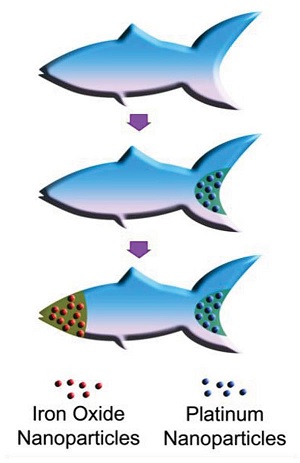 |
| Courtesy of UCSD |
In a new proof-of-concept study, University of California, San Diego engineers have designed fish-shaped microrobots capable of swimming through liquids. These tiny 3-D printed fish can potentially deliver drugs by steering themselves with nanoparticles installed in their "tails" and "heads."
The microrobots are literally shaped like fish, with fins and tails, 3-D printed with UCSD technology to "swim" in a solution containing hydrogen peroxide. The fish contain platinum nanoparticles in their tails to move them forward and iron oxide nanoparticles in their heads with which to direct them via magnets.
To show that the microfish worked, the scientists used toxin-neutralizing nanoparticles such as those in bee venom to detoxify an environment. They lit up with fluorescence when they picked up the toxins. The research was published in the Aug. 12 issue of the journal Advanced Materials.
"We have developed an entirely new method to engineer nature-inspired microscopic swimmers that have complex geometric structures and are smaller than the width of a human hair," lead author Wei Zhu said in a statement. "With this method, we can easily integrate different functions inside these tiny robotic swimmers for a broad spectrum of applications."
The researchers made the fish using a high-resolution 3-D printing technology developed in the lab. The microscale continuous optical printing allows for the manufacture of hundreds of microfish on a sheet, each with its own layout of nanoparticle sections.
"This method has made it easier for us to test different designs for these microrobots and to test different nanoparticles to insert new functional elements into these tiny structures. It's my personal hope to further this research to eventually develop surgical microrobots that operate safer and with more precision," co-author Jinxing Li said.
- here's the UCSD report
- get the research abstract